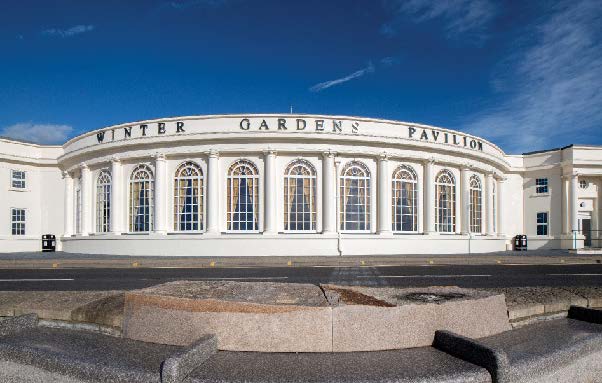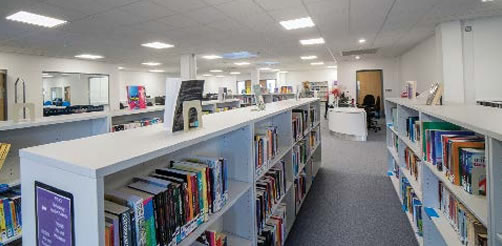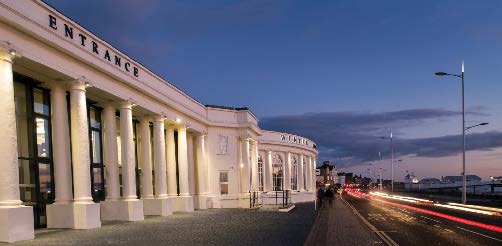Winter Gardens
Weston-super-Mare, North Somerset
Project Details
Client
Weston College
Project Manager
Weston College
Architect
View Architects Ltd
Contractor
Midas Construction Ltd
Value
£9.9 million
Contract Period
72 weeks
Procurement Type
Competitive tender – 2 stage
Form of Contract
JCT Design & Build 2011
Size
5,456m²
Apprentices
15
Project Summary
The restored Winter Gardens Pavilion is an iconic seafront venue for conferences, ceremonies and events, including smaller conference and meeting rooms. Designed in 1924 and first opened in 1927, the Pavilion features a neo-Georgian ballroom with dome and a rear 1980s extension, now fully refurbished into a modern two-storey educational centre with double-height reception space, housing Weston College’s new Law and Professional Services Academy and The Florentine bistro. Facing the seafront is Lasseter’s, a two-storey fine dining restaurant with a seafront patio area surrounded by glass screens.
This BREEAM Very Good project included demolition, refurbishment, reconfiguration and extension works, on a challenging location in the centre of town. Works included refurbishment of the ballroom; reconfiguration and refurbishment of the 1980s extension; and demolition and reconstruction of the rear section to create a two-storey entrance. Midas modernised the Pavilion, improving natural ventilation and daylight and retaining design sympathetic to the building’s heritage.
The project captured the interest of local groups and historical preservation societies, who went on to form a Local Steering Group with the aim of ensuring the College and Council respected the Pavilion’s status as a building of local significance.
“I am delighted with the end result, these new facilities will offer our students first-class facilities and provide the best education possible. Throughout the project our students have been involved, from placements with Midas to designing the new Winter Gardens logo. Here at Weston College, we put our students first in everything we do, and so it was of utmost importance that they could feel involved in such a huge project that will go on to benefit them and the local area.”
Community Engagement
Click here to add your own text
Key Challenges
The Pavilion is a designated building of local significance with strict planning approval controls.
Midas worked closely with the local authority’s planning department to agree planning approval for the design and materials, including replacement of the Pavilion’s large, curved ballroom windows. The local authority considered the windows to be an iconic part of the building; however, the timber frames had rotted through. Midas agreed their replacement with aluminium frames, sympathetically designed to be as similar as possible to the original frames whilst providing the required weather protection and security. Redesigning and retendering the windows saved £32,000 and achieved a solution accepted by the local planners.
Designed in 1924 and opened in 1927, the Pavilion and ballroom were past their maximum lifespan expectancy.
Midas worked with a specialist restoration company to restore the ballroom dome. Midas designed a bespoke mesh retention system, which is now being used as a method standard. The team fitted 3,000 structural bolts with 33,000 staples to pin the mesh into place on the curve of the dome; then sprayed the inside of the dome with an eco-friendly acoustic treatment formed from recycled paper and glue. The finished result has secured the dome and improved the acoustics of the ballroom, reducing the echo problems the hall had previously experienced.
Seafront site exposed to gale force winds and extreme weather.
The exposed location required periods of down time during high winds to ensure staff safety. Midas scheduled the programme to complete a large section of the high level and external works during spring and summer, with milder weather. The team worked weekends and additional hours to make up time lost during bad weather and sub-sectioned the works into different zones, with a manager to supervise works in each zone, enabling works to progress at different paces.
Restricted town centre site with limited drop off, stopping or unloading areas and confined external space.
To manage the constrained site, Midas restricted access times in accordance with local noise and working hours limitations. The site employed a full time vehicle controller to monitor all deliveries to the site and with planned deliveries only, scheduled to avoid rush hour, local retailers’ delivery slots and peak shopping periods. Midas leased a small parcel of adjacent land from the town council for deliveries, and rented parking spaces for contractors from an adjacent hotel.
The client had limited funds at the commencement of works, with their original budget being £1.8m less than the cost for the scope of works they preferred.
Midas completed a collaborative best value review to offer a £728k cost reduction at Gateway 3 but with £832k of best practice and added value benefits built in. This included an alternative roof finish, with a Soprema over-coating in place of stripping the roof, providing an improved lifespan and a saving of £60,500; an extensive review of M&E, finishes and decoration, combining services and functions where possible at a saving of £115,000; and redesigning the building to keep within the original footprint and reuse the existing foundations, for a saving of circa £300,000.
Project Takeaways
Our Success
- The structural engineer found the original 1920s architectural drawings in the County Hall Archive, and used these to analyse the existing foundations and inform a more detailed survey. This enabled us to retain existing floor slabs and reduce substructure costs, saving £200,000, and ensured our detailed understanding of the building meant only unavoidable intrusive surveys.
- The Midas Quantity Surveyor developed a Project Cost tracker, shared at weekly reviews with the client team, to keep all parties informed of progress and enable timely decision-making. This ensured Midas developed the design to budget.
- To manage the site’s exposure to gale force winds and extreme weather, Midas changed the roofing specification to avoid stripping the roof, and designed a steel frame to reduce the number of crane lifts. This mitigated the impact of bad weather, reducing programme risk and saving time and enabling the project to finish on the contracted completion date.
Our Learnings
- The local community, including the local Civic Society, Heritage Group and some neighbouring land owners expressed concern regarding the project and formed a Local Steering Group shortly after Weston College purchased the building. The Midas site team worked closely with this group to keep them informed of planned works and maintain a positive working relationship. Midas held monthly meetings with the Steering Group and hosted three site tours for their members, with ten to 15 people attending each tour.
- The client could only issue instruction of excluded listed building and fit out works once they received confirmation of secured Local Enterprise Partnership (LEP) funding. Confirmation of LEP funding was received late in the programme, which Midas managed by collaboratively supporting the client in firming up the cost of these additional works. Midas reduced preliminary cost increases to only £84k by absorbing over £1.8m of additional works into the programme with only six weeks increase in programme period.
Value Added
- Achievement of BREEAM Very Good included installation of a PV array to provide 10% of the predicted energy use of the building, as required to comply with North Somerset Core Strategy policy. The array is 21m² and generates approximately 1713kWh of electricity per year, equating to a CO2 saving of 0.763 tonnes of CO2/annum.
- Midas supported the Employment and Skills Plan (ESP) through work experience placements for 14-17 year olds plus curriculum support activities. The construction team provided mock interviews for Year 10 students at Priory Community School; gave a tour for Utilities Higher National Certificate (HNC) students from Weston College; provided a graduate placement for a female assistant quantity surveyor from Weston College; and delivered training sessions for seven subcontractors.
- The site supported the local economy: 87% companies employed via the project were SMEs and the site used 62% local labour.
- Through close collaborative working £1.1m of best practice and added value benefits were ultimately delivered by project completion Gateway 4.
KPI’s & Statistics
| Contract | Gateway 2 – Planning | Gateway 3 Contract Agreement | Variation |
| Cost | £8,722,853 | £7,994,951 | -£727,902 (-8.3%) |
| Time | 52.6 Weeks | 54 weeks | 1.43 weeks 2.7% |
KPI Graphs
Apprentices: 15
Graduates: 3
Average AIR: 0
Average CCS score: 37.5
Waste diverted from landfill: 97.6%
Cost/m2: £1,805m²
Cost/m2 excl abnormals: £1,643m²
Cost/m2 Industry average £ m²






